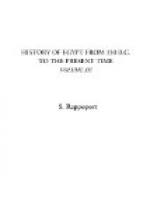[Illustration: 241.jpg THE NILE BARRAGE]
It proved to be of the greatest advantage in saving labour worth hundreds of thousands of dollars a year, and in the irrigation and navigation facilities that had been contemplated as among the benefits which would naturally accrue from its successful completion.
Compared with the advance of the land seaward at the estuary of the Mississippi and the Ganges, the advance of the Nile seaward is very slow. This is accounted for by the geological theory that the Delta of the Nile is gradually sinking. If this is so, the tendency of the periodical deposit to raise the level of the Delta will be counteracted by the annual subsidence. These phenomena account for the gradual burial of Egyptian monuments under the sand, although the actual level of the sea above what it formerly was is quite unappreciable.
The periodical rise in the Nile, recurring as regularly as the revolutions of the heavenly bodies, necessarily remained an unsolved mystery to the ancients, for until the discovery of the tropical regions, with their mountainous lakes and deluging rains, it was impossible to learn the occasion of this increase. It is now known that the Blue Nile, flowing out of the mountainous parts of Abyssinia, is the sole cause of the periodic overflow of the Nile. Without the tropical rains of the Ethiopian tablelands, there would be no great rise nor any fertilising deposits. Without the White Nile, which runs steadily from the perennial reservoirs of the great Central African lakes, the Lower Nile would assume the character of an intermittent wady, such as the neighbouring Khor Baraka, periodically flushed by the discharge of the torrential downpours from Abyssinia. Though there is a periodical increase in the flow of the upper waters of the White Nile, yet the effect of this, lower down, is minimised by the dense quantities of vegetable drift, which, combining with the forest of aquatic growth, forms those vast barriers, known by the name of sudd, which not only arrest navigation but are able to dam up large bodies of water.
The sudd, it is supposed, stopped the advance of the Roman centurions who were sent up the Nile in the days of Nero. Sir Samuel Baker was the one who first pointed out the great disadvantage of allowing the vegetable matter to accumulate, both to merchants and to those who were employed to suppress the slave-trade. In the year 1863 the two branches of the White Nile were blocked above their junction at Lake No. Once blocked, the accumulation rapidly increased from the stoppage of outlet, forming the innumerable floating islands which at this part of the Nile customarily float down-stream. A marsh of vast extent had been formed, and to all appearance, as Baker narrates, the White Nile had disappeared. Baker cut through fifty miles of the sudd, and urged the khedive to reopen the Nile. The work was successfully undertaken by Ishmail Ayub Pasha, and the White Nile became clear




